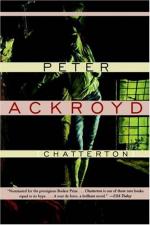|
This section contains 689 words (approx. 2 pages at 400 words per page) |

|
Chatterton Summary & Study Guide Description
Chatterton Summary & Study Guide includes comprehensive information and analysis to help you understand the book. This study guide contains the following sections:
This detailed literature summary also contains Topics for Discussion and a Free Quiz on Chatterton by Peter Ackroyd.
Chatterton begins in modern time, following a young English poet into an antique shop where he hopes to make a little extra cash for his financially struggling family. Instead he finds a portrait of a middle-aged gentleman that catches his attention so completely that he forgets the money he came to earn and instead makes an even trade for the portrait. Charles Wychwood, the poet, quickly becomes obsessed with the portrait when he discovers, with the help of a friend, that it resembles the poet Thomas Chatterton, who reportedly died when he was only seventeen.
Charles travels to meet the original owner of the painting and receives a set of documents from the owner's lover. While sorting these documents, Charles discovers a manuscript with the initials T.C. signed across the bottom. The manuscripts appears to be a confession of sorts, Chatterton's confession of having faked his own death and continuing to write under the guise of many famous poets of the time period, including William Blake. Charles takes these documents to an old friend of his from college and asks him to examine them and determine when the documents were written. His friend confirms that the documents were written around the turn of the century, which was more than thirty years after Chatterton's death.
Charles's employer, an elderly novelist, learns of these documents and makes it her single-minded mission to get possession of them and write a book about them. It is the discovery of the century, she believes, one that will change the world of literature and poetry forever. This novelist, Harriet Scrope, goes to Charles's wife to plant the seeds of her deception and finds a woman deeply troubled. Charles has been sick, she confesses. Charles's wife, Vivien, is terribly afraid for his health.
It is not long after this conversation between Harriet Scrope and Vivien that Charles invites his closest friends to dinner: Harriet, the manuscript expert, Andrew Flint, Charles's old college chum Phillip, and his wife Vivien. Dinner becomes a discussion of poetry and the state of modern literature. With the aid of wine and gin, the arguments become heated until Charles suddenly rises from the table clutching his head. He returns after a moment to resume the conversation, only to mumble a few syllables and collapse on the floor. Soon after, Charles dies from a brain tumor.
All through Charles's obsession with the painting and the manuscript, the reader is also allowed little peeks into the creation of the only known portrait of Chatterton, which in reality is a portrait of George Meredith, another poet, pretending to be Chatterton. During these flashbacks, the reader watches the artist, Henry Wallis, grow increasingly fascinated with Meredith's wife, Mary Ellen Meredith. This fascination grows while Wallis works on the portrait, culminating in an affair between the two when the portrait is completed. It is later rumored that Meredith was so distraught over his wife's betrayal that he attempted to commit suicide inside the church where Chatterton grew up and is saved by Chatterton's ghost.
Throughout the end of the novel, the narration also visits Chatterton's last day of life. Chatterton was an intelligent young man, full of life and enthusiasm for his chosen profession. It is only a bad decision and a night of too much drink that causes him to take an overdose of a homemade medical remedy that results in his death.
Phillip, Charles's best friend, returns to the home of the gentlemen who gave Charles the Chatterton manuscripts shortly after Charles's death and asks about their true origin. Phillip learns that the manuscripts were a joke written by the man who published the majority of Chatterton's work during his life and many years afterward, a Mr. Joynson. He apparently became upset when a rival book publisher published some of Chatterton's letters that accused Joynson of taking his manuscripts and then abandoning him. Joynson believed should his joke ever become public it would humiliate Chatterton's reputation and save his own. Phillip returns the manuscripts to the original owner. The painting, however, is destroyed when an artist attempts to restore it.
Read more from the Study Guide
|
This section contains 689 words (approx. 2 pages at 400 words per page) |

|



